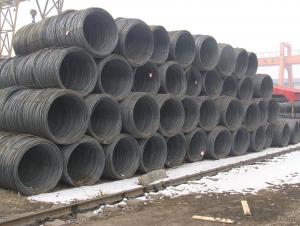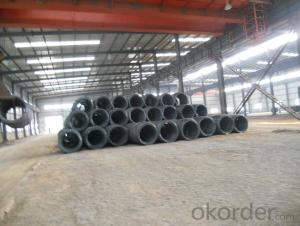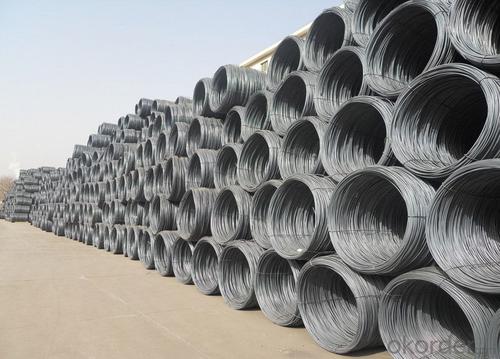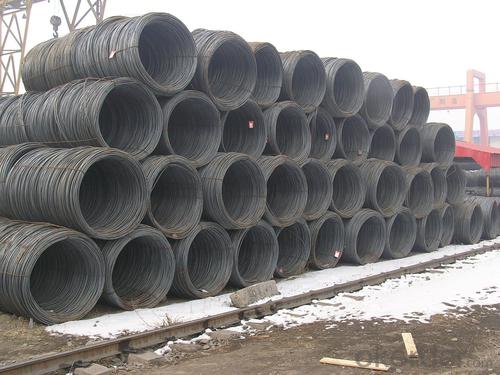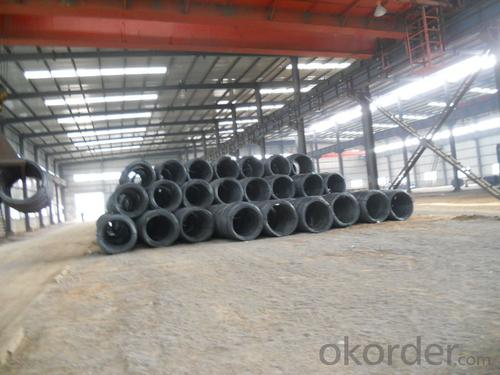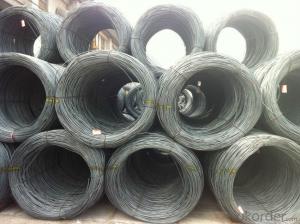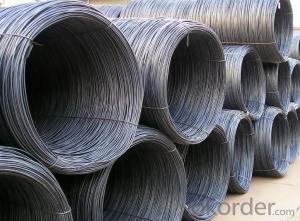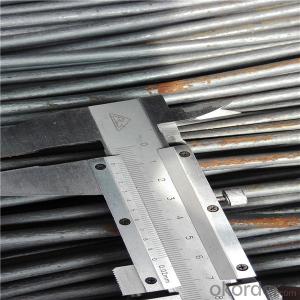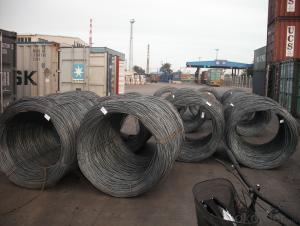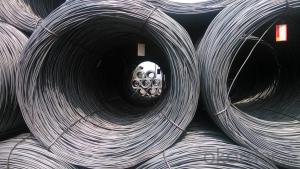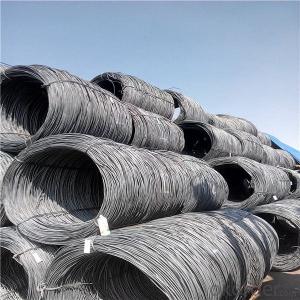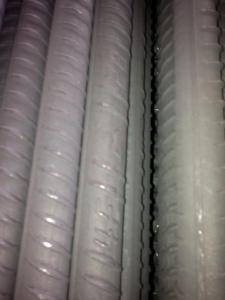Low Carbon Hot Rolled Steel Wire Rod in Coil
- Loading Port:
- China main port
- Payment Terms:
- TT OR LC
- Min Order Qty:
- 100 m.t.
- Supply Capability:
- 10000 m.t./month
OKorder Service Pledge
OKorder Financial Service
You Might Also Like
Specification
Product Description:
OKorder is offering Low Carbon Hot Rolled Steel Wire Rod in Coil at great prices with worldwide shipping. Our supplier is a world-class manufacturer of steel, with our products utilized the world over. OKorder annually supplies products to African, South American and Asian markets. We provide quotations within 24 hours of receiving an inquiry and guarantee competitive prices.
Product Applications:
Low Carbon Hot Rolled Steel Wire Rod in Coil are ideal for structural applications and are widely used in construction and manufacturing. Carbon steel wire rod is mainly used for reinforcement of reinforced concrete and welded structure or reprocessed (roberts , nail, etc.) materials, especially used to produce wire drawing, welding electrode, nails, spring, electronic, precise machinery parts and so on.
Product Advantages:
OKorder's Low Carbon Hot Rolled Steel Wire Rod in Coil are durable, strong, and wide variety of sizes.
Main Product Features:
· Premium quality
· Prompt delivery & seaworthy packing (30 days after receiving deposit)
· Can be recycled and reused
· Mill test certification
· Professional Service
· Competitive pricing
Product Specifications:
Manufacture: Hot rolled
Grade: Q195 – 235
Certificates: ISO, SGS, BV, CIQ
Packaging: Export packing, nude packing, in coils, each coil around 2mt
Size: 5.5mm, 6.5mm, 8mm, 10mm
Chemical composition (%): | C | Si | Mn | P | S | Ceq | |||
HRB335 HRBF335 |
0.25 |
0.80 |
1.60 |
0.045 |
0.045 | 0.52 | |||
HRB400 HRBF400 | 0.54 | ||||||||
HRB500 HRBF500 | 0.55 | ||||||||
Mechanical properties | Steel | Rel/ MPa | Rm/ MPa | A/ % | Agt/ % | ||||
≥ | |||||||||
HRB335 HRBF335 | 335 | 455 | 17 |
7.5 | |||||
HRB400 HRBF400 | 400 | 540 | 16 | ||||||
HRB500 HRBF500 | 500 | 630 | 15 | ||||||
FAQ:
Q1: Why buy Materials & Equipment from OKorder.com?
A1: All products offered byOKorder.com are carefully selected from China's most reliable manufacturing enterprises. Through its ISO certifications, OKorder.com adheres to the highest standards and a commitment to supply chain safety and customer satisfaction.
Q2: How do we guarantee the quality of our products?
A2: We have established an advanced quality management system which conducts strict quality tests at every step, from raw materials to the final product. At the same time, we provide extensive follow-up service assurances as required.
Q3: How soon can we receive the product after purchase?
A3: Within three days of placing an order, we will arrange production. The normal sizes with the normal grade can be produced within one month. The specific shipping date is dependent upon international and government factors, the delivery to international main port about 45-60days.
Images:
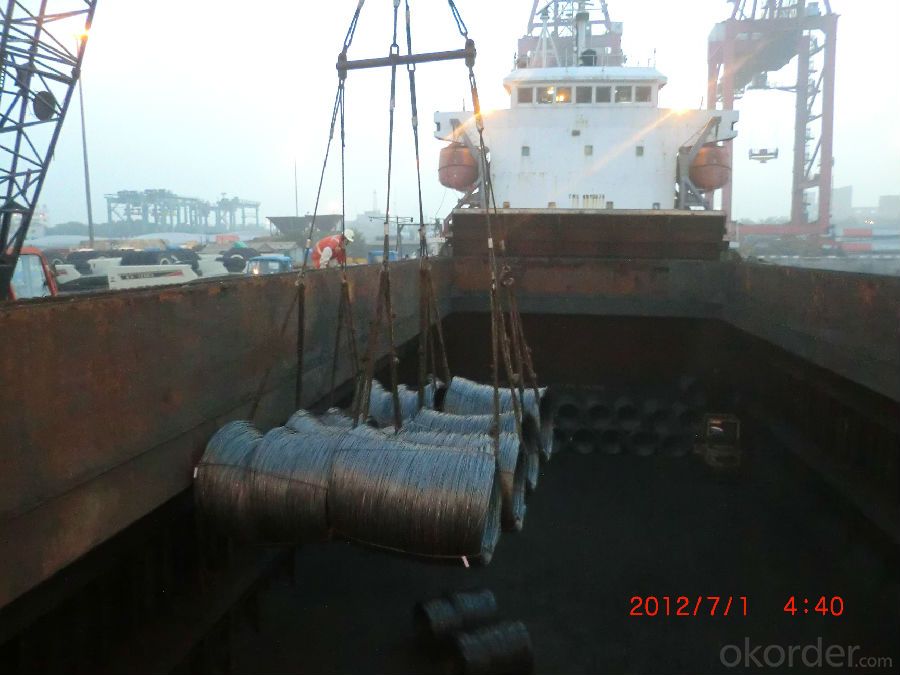
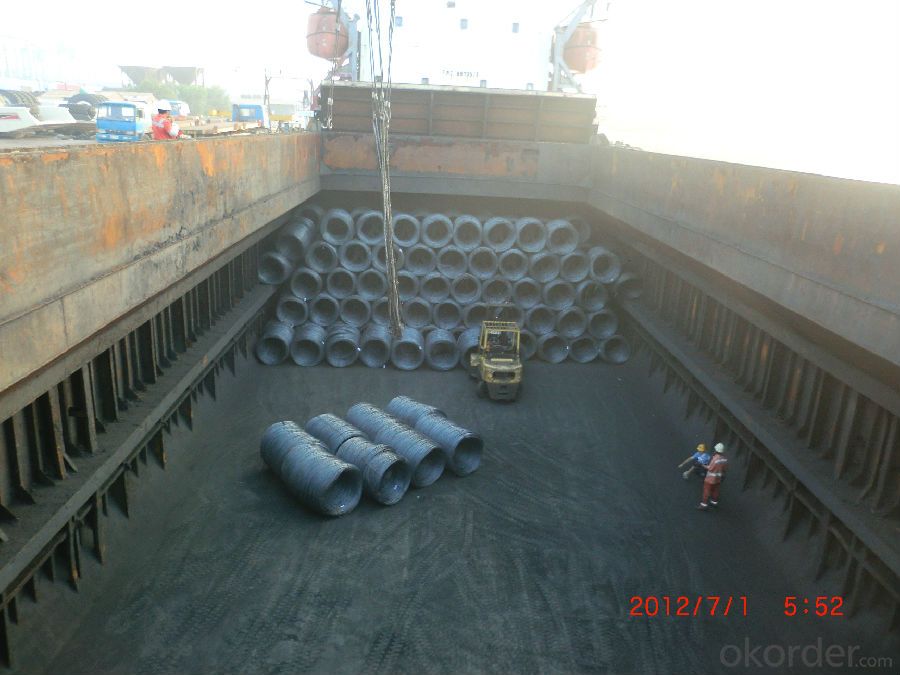
- Q: Can steel wire rod be used in high-temperature applications?
- Steel wire rod can be used in high-temperature applications, but it is important to consider the specific type of steel used and the temperatures involved. Certain grades of steel, such as stainless steel or heat-resistant alloys, are specifically designed to withstand high temperatures without significant loss of strength or structural integrity. These types of steel are often used in industries such as aerospace, automotive, and power generation, where exposure to high temperatures is common. However, not all steel wire rods are suitable for high-temperature applications. Some lower-grade steels may experience a decrease in mechanical properties, such as tensile strength, ductility, and corrosion resistance, when exposed to elevated temperatures. It is crucial to consult the manufacturer's specifications or seek expert advice to determine if a particular steel wire rod is appropriate for the intended high-temperature environment. Additionally, other factors such as the operating conditions, duration of exposure, and presence of other corrosive elements or chemicals should be taken into account when considering the use of steel wire rod in high-temperature applications. Regular monitoring and maintenance may be necessary to ensure the continued performance and safety of the steel wire rod in such environments.
- Q: Types of wire rods
- Hexagonal, fan-shaped and other special-shaped wire rods; the upper limit of diameter has been extended to 38 mm; the plate weight has increased from 40-60 kg to 3000 kg. Because of the development of new heat treatment process, the iron oxide sheet on the wire rod has been obviously thinned, and its microstructure and properties have also been greatly improved.
- Q: How is the weldability of steel wire rod evaluated?
- Different techniques and criteria are used to assess the weldability of steel wire rod. An important aspect in evaluating weldability is the chemical composition of the rod. The presence of certain elements, like carbon, sulfur, and phosphorus, can greatly affect how well the material can be welded. The mechanical properties of the wire rod, including tensile strength, ductility, and toughness, are also crucial considerations. These properties can impact the weld joint's quality and integrity. The surface condition of the wire rod is another factor that needs to be evaluated for weldability. Any contaminants or impurities on the surface can have a negative impact on the weldability and lead to defects. Moreover, the welding process and parameters used have a significant role in determining the weldability of the wire rod. Factors like heat input, welding speed, and selection of shielding gas need to be optimized to ensure proper fusion and minimize the risk of defects. Various tests and inspections are conducted to evaluate weldability. This includes visually examining the weld for defects such as cracks, porosity, or incomplete fusion. Non-destructive testing methods like ultrasonic testing or radiography can be used to detect internal flaws or inconsistencies. In addition, mechanical tests like tensile and bend testing are performed to assess the strength and ductility of the weld joint. These tests help determine the overall quality and performance of the welded wire rod. In conclusion, the weldability of steel wire rod is evaluated by considering factors such as chemical composition, mechanical properties, surface condition, welding process, and conducting tests and inspections to ensure the quality and integrity of the weld joint.
- Q: How is steel wire rod used in the manufacturing of razor wire?
- Steel wire rod is an essential component in the manufacturing of razor wire as it serves as the base material for creating the sharp and pointed blades. The wire rod is first drawn through various dies to reduce its diameter and increase its strength. Then, it is cut into individual lengths and sharpened to form the razor-like edges. These sharp wire rods are then tightly twisted and interlinked to create the distinctive and effective barrier known as razor wire.
- Q: What are the main factors affecting the market research of steel wire rod?
- The main factors affecting the market research of steel wire rod include supply and demand dynamics, price fluctuations, industry regulations, technological advancements, competitor analysis, and consumer preferences. Additionally, factors like raw material availability, production capacity, global economic conditions, and geopolitical events also play a significant role in influencing the market research of steel wire rod.
- Q: What are the common heat treatment processes for steel wire rod?
- Steel wire rods undergo various heat treatment processes to enhance their properties and characteristics. These processes, including annealing, quenching, tempering, and normalizing, serve specific purposes. 1. Annealing involves heating the steel wire rod to a specific temperature and maintaining it for a certain duration, followed by controlled cooling. This process enhances the material's ductility and machinability by reducing its hardness and brittleness. 2. Quenching is a rapid cooling process in which the heated wire rod is immersed in a quenching medium like oil or water. This rapid cooling increases the wire rod's strength and hardness but also makes it more brittle. 3. Tempering is done after quenching to reduce brittleness and relieve internal stresses. The quenched wire rod is heated to a specific temperature and held there for a certain period, followed by controlled cooling. Tempering improves the wire rod's toughness and ductility while maintaining a desirable level of strength. 4. Normalizing is a heat treatment process similar to annealing, but with a different cooling method. The wire rod is heated above its transformation range and allowed to cool in still air. Normalizing refines the material's grain structure, improving its mechanical properties and reducing internal stresses. These heat treatment processes can be combined and modified to achieve specific desired properties for steel wire rods. The choice of process depends on factors such as the desired mechanical properties, intended application, and the type of steel being treated.
- Q: What are the main producers of steel wire rod?
- The main producers of steel wire rod are countries such as China, Japan, United States, India, and Russia.
- Q: What are the common applications of galvanized and oil tempered steel wire rod?
- Due to its protective zinc coating, galvanized steel wire rod finds wide application in various fields. The galvanization process involves applying a layer of zinc to the surface of the steel wire rod, which offers excellent resistance against corrosion. This makes galvanized steel wire rod the ideal choice for situations where the material will be exposed to moisture, chemicals, or harsh environments. Some common uses of galvanized steel wire rod include: 1. Fencing and wire mesh: Galvanized steel wire rod is extensively utilized in the construction of fences and wire mesh. The zinc coating helps to prevent rust and corrosion, ensuring the long-lasting and durable nature of the fencing or mesh. 2. Construction: Galvanized steel wire rod is employed in numerous construction applications, such as reinforcing concrete. The added strength and corrosion resistance of galvanized steel make it an excellent option for reinforcing structures and providing stability. 3. Automotive industry: Galvanized steel wire rod is used in the manufacture of automotive parts and components. It is often employed in the production of springs, suspension systems, and wire harnesses due to its high strength and resistance to corrosion. 4. Electrical applications: Galvanized steel wire rod is commonly used in electrical applications, including cable armor and grounding wires. The zinc coating provides an extra layer of protection against corrosion, ensuring the safety and reliability of electrical systems. On the other hand, oil tempered steel wire rod is a high-strength material that undergoes heat and oil treatment to improve its mechanical properties. This process involves heating the steel wire rod to a specific temperature and then quenching it in oil. The result is a wire rod with enhanced toughness, durability, and resistance to fatigue. Some common uses of oil tempered steel wire rod include: 1. Springs: Oil tempered steel wire rod is widely employed in the production of springs, such as coil springs, suspension springs, and valve springs. The high strength and excellent fatigue resistance of oil tempered steel make it ideal for applications that require reliable and long-lasting springs. 2. Mechanical components: Oil tempered steel wire rod is used in the manufacture of various mechanical components, including shafts, gears, and fasteners. Its high strength and toughness make it suitable for applications where durability and reliability are crucial. 3. Automotive industry: Oil tempered steel wire rod is extensively utilized in the automotive industry for applications such as seat frames, seat belts, and suspension systems. The superior mechanical properties of oil tempered steel ensure the safety and performance of automotive components. 4. Industrial equipment: Oil tempered steel wire rod is employed in a wide range of industrial equipment, such as conveyor belts, wire ropes, and crane cables. Its high tensile strength and resistance to fatigue make it an ideal material for handling heavy loads and enduring demanding conditions. In conclusion, both galvanized and oil tempered steel wire rods have their unique applications and advantages. Galvanized steel is primarily selected for its corrosion resistance, while oil tempered steel is chosen for its high strength and durability.
- Q: How is steel wire rod used in the production of wire baskets?
- Steel wire rod is used in the production of wire baskets as it serves as the primary material for creating the basket's structure. The wire rod is first shaped and welded to form the basket's frame, providing the necessary strength and durability. Additionally, the steel wire rod can be further processed to create the mesh or grid pattern that forms the sides and base of the basket, allowing for the containment and organization of various items.
- Q: Round steel. Wire rod. Is a high wire a kind of thing?
- Wire rod (Rod): coil finished products after hot rolling, including round, square, rectangular, six corners, etc.. Because most of them are round, the wire rod is generally referred to as round wire rod. According to the different material mill was divided into high speed wire (wire) and ordinary wire (P line) two.
Send your message to us
Low Carbon Hot Rolled Steel Wire Rod in Coil
- Loading Port:
- China main port
- Payment Terms:
- TT OR LC
- Min Order Qty:
- 100 m.t.
- Supply Capability:
- 10000 m.t./month
OKorder Service Pledge
OKorder Financial Service
Similar products
Hot products
Hot Searches
Related keywords

